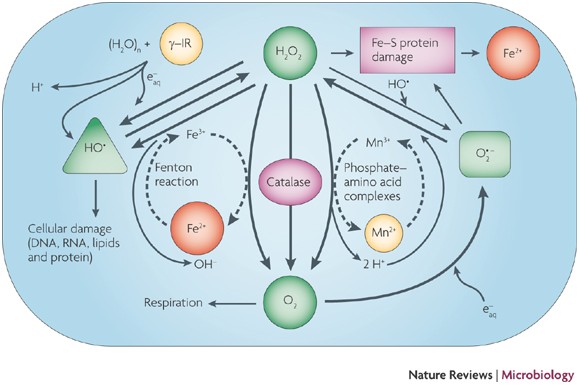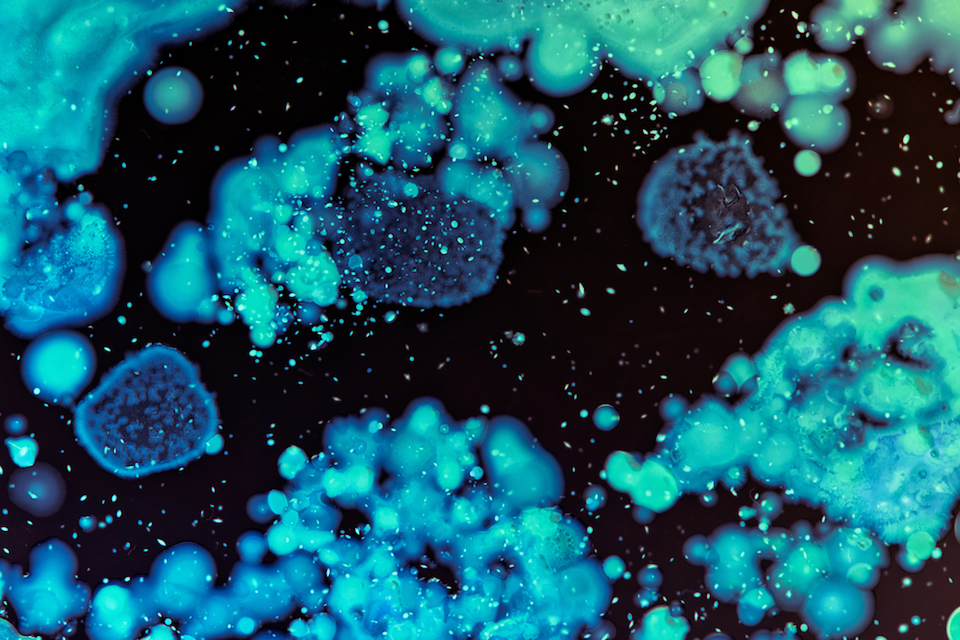Molecular repertoire of Deinococcus radiodurans after 1 year of
Por um escritor misterioso
Last updated 11 abril 2025

Background The extraordinarily resistant bacterium Deinococcus radiodurans withstands harsh environmental conditions present in outer space. Deinococcus radiodurans was exposed for 1 year outside the International Space Station within Tanpopo orbital mission to investigate microbial survival and space travel. In addition, a ground-based simulation experiment with conditions, mirroring those from low Earth orbit, was performed. Methods We monitored Deinococcus radiodurans cells during early stage of recovery after low Earth orbit exposure using electron microscopy tools. Furthermore, proteomic, transcriptomic and metabolomic analyses were performed to identify molecular mechanisms responsible for the survival of Deinococcus radiodurans in low Earth orbit. Results D. radiodurans cells exposed to low Earth orbit conditions do not exhibit any morphological damage. However, an accumulation of numerous outer-membrane-associated vesicles was observed. On levels of proteins and transcripts, a multi-faceted response was detected to alleviate cell stress. The UvrABC endonuclease excision repair mechanism was triggered to cope with DNA damage. Defense against reactive oxygen species is mirrored by the increased abundance of catalases and is accompanied by the increased abundance of putrescine, which works as reactive oxygen species scavenging molecule. In addition, several proteins and mRNAs, responsible for regulatory and transporting functions showed increased abundances. The decrease in primary metabolites indicates alternations in the energy status, which is needed to repair damaged molecules. Conclusion Low Earth orbit induced molecular rearrangements trigger multiple components of metabolic stress response and regulatory networks in exposed microbial cells. Presented results show that the non-sporulating bacterium Deinococcus radiodurans survived long-term low Earth orbit exposure if wavelength below 200 nm are not present, which mirrors the UV spectrum of Mars, where CO2 effectively provides a shield below 190 nm. These results should be considered in the context of planetary protection concerns and the development of new sterilization techniques for future space missions. Video Abstract

Protein damage and death by radiation in Escherichia coli and Deinococcus radiodurans

The radioresistant and survival mechanisms of Deinococcus radiodurans

Deinococcus radiodurans PprI Switches on DNA Damage Response and Cellular Survival Networks after Radiation Damage - ScienceDirect

PDF] Proteometabolomic response of Deinococcus radiodurans exposed to UVC and vacuum conditions: Initial studies prior to the Tanpopo space mission

PDF) Molecular repertoire of Deinococcus radiodurans after 1 year of exposure outside the International Space Station within the Tanpopo mission

A) Survival of D. radiodurans and crtB with regolith following the

PDF] Proteometabolomic response of Deinococcus radiodurans exposed to UVC and vacuum conditions: Initial studies prior to the Tanpopo space mission

Molecular repertoire of Deinococcus radiodurans after 1 year of exposure outside the International Space Station within the Tanpopo mission, Microbiome

Frontiers Deinococcus radiodurans Exopolysaccharide Inhibits Staphylococcus aureus Biofilm Formation

Molecular response of Deinococcus radiodurans to simulated microgravity explored by proteometabolomic approach

A new perspective on radiation resistance based on Deinococcus radiodurans
Recomendado para você
-
 Better Know a Microbe: Deinococcus11 abril 2025
Better Know a Microbe: Deinococcus11 abril 2025 -
Radiation-resistant bacterium could be key to faster, safer, more11 abril 2025
-
Efficient bioremediation of radioactive iodine using biogenic gold11 abril 2025
-
Thin section electron micrograph of (a) D. radiodurans R1 tetrad11 abril 2025
-
 Microbial space travel on a molecular scale: How extremophilic11 abril 2025
Microbial space travel on a molecular scale: How extremophilic11 abril 2025 -
 The RecA proteins of Deinococcus radiodurans and Escherichia coli11 abril 2025
The RecA proteins of Deinococcus radiodurans and Escherichia coli11 abril 2025 -
 Metabolic engineering of Deinococcus radiodurans for pinene11 abril 2025
Metabolic engineering of Deinococcus radiodurans for pinene11 abril 2025 -
 Bug of the Week11 abril 2025
Bug of the Week11 abril 2025 -
 RCSB PDB - 4H6R: Structure of reduced Deinococcus radiodurans11 abril 2025
RCSB PDB - 4H6R: Structure of reduced Deinococcus radiodurans11 abril 2025 -
 Radiation resistant bacteria, SEM - Stock Image - B244/006111 abril 2025
Radiation resistant bacteria, SEM - Stock Image - B244/006111 abril 2025
você pode gostar
-
 Troy Baker joins Uncharted 4 as Nathan Drake's brother11 abril 2025
Troy Baker joins Uncharted 4 as Nathan Drake's brother11 abril 2025 -
 Figura de Ação ROBLOX Multipack Field Trip z (Idade Mínima: 6)11 abril 2025
Figura de Ação ROBLOX Multipack Field Trip z (Idade Mínima: 6)11 abril 2025 -
 Leo Borensztein (GMLeozinho2408) - Chess Profile11 abril 2025
Leo Borensztein (GMLeozinho2408) - Chess Profile11 abril 2025 -
 Cuba v Venezuela - FIBA Women's AmeriCup 2023 - 3 minute game11 abril 2025
Cuba v Venezuela - FIBA Women's AmeriCup 2023 - 3 minute game11 abril 2025 -
 Ben 10: Destroy All Aliens (2012)11 abril 2025
Ben 10: Destroy All Aliens (2012)11 abril 2025 -
Dr. Campos Costa, PDF, Equipamento médico11 abril 2025
-
 Erick Mafra on X: Vocês já tentaram fazer a carinha de Erick??? 😌😌😌 O @joaoguilherme quer dizer, a “Sharlene” tentou e não deu muito certo! Dormiu! HAHA 😴😴😴 A Sharlene ficou sabendo11 abril 2025
Erick Mafra on X: Vocês já tentaram fazer a carinha de Erick??? 😌😌😌 O @joaoguilherme quer dizer, a “Sharlene” tentou e não deu muito certo! Dormiu! HAHA 😴😴😴 A Sharlene ficou sabendo11 abril 2025 -
/i.s3.glbimg.com/v1/AUTH_08fbf48bc0524877943fe86e43087e7a/internal_photos/bs/2022/H/q/qrAp8gRwWbbSvMWozNiQ/2019-01-14-the-last-of-us-part-ii-e3-2018-screen-01-ps4-us-10jul18.jpg) The Last of Us 2, Software11 abril 2025
The Last of Us 2, Software11 abril 2025 -
 Create Your Own Unblocked Game Site11 abril 2025
Create Your Own Unblocked Game Site11 abril 2025 -
 Masquerade (2010)11 abril 2025
Masquerade (2010)11 abril 2025

